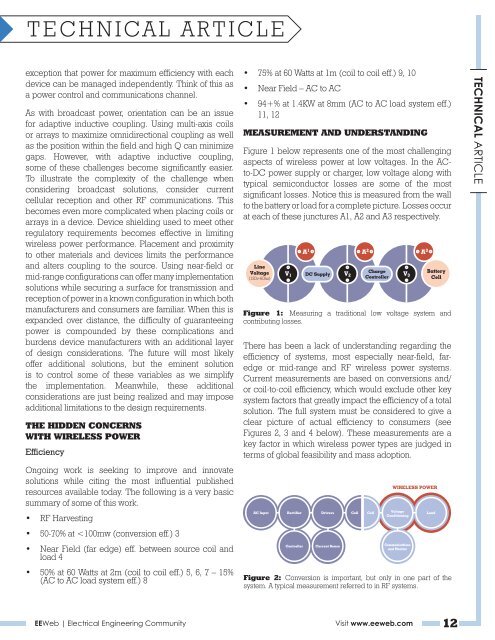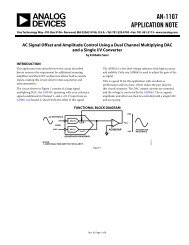Interview with Laurent Desclos - EEWeb
Interview with Laurent Desclos - EEWeb
Interview with Laurent Desclos - EEWeb
You also want an ePaper? Increase the reach of your titles
YUMPU automatically turns print PDFs into web optimized ePapers that Google loves.
TECHNICAL ARTICLE<br />
exception that power for maximum efficiency <strong>with</strong> each<br />
device can be managed independently. Think of this as<br />
a power control and communications channel.<br />
As <strong>with</strong> broadcast power, orientation can be an issue<br />
for adaptive inductive coupling. Using multi-axis coils<br />
or arrays to maximize omnidirectional coupling as well<br />
as the position <strong>with</strong>in the field and high Q can minimize<br />
gaps. However, <strong>with</strong> adaptive inductive coupling,<br />
some of these challenges become significantly easier.<br />
To illustrate the complexity of the challenge when<br />
considering broadcast solutions, consider current<br />
cellular reception and other RF communications. This<br />
becomes even more complicated when placing coils or<br />
arrays in a device. Device shielding used to meet other<br />
regulatory requirements becomes effective in limiting<br />
wireless power performance. Placement and proximity<br />
to other materials and devices limits the performance<br />
and alters coupling to the source. Using near-field or<br />
mid-range configurations can offer many implementation<br />
solutions while securing a surface for transmission and<br />
reception of power in a known configuration in which both<br />
manufacturers and consumers are familiar. When this is<br />
expanded over distance, the difficulty of guaranteeing<br />
power is compounded by these complications and<br />
burdens device manufacturers <strong>with</strong> an additional layer<br />
of design considerations. The future will most likely<br />
offer additional solutions, but the eminent solution<br />
is to control some of these variables as we simplify<br />
the implementation. Meanwhile, these additional<br />
considerations are just being realized and may impose<br />
additional limitations to the design requirements.<br />
THE HIDDEN CONCERNS<br />
WITH WIRELESS POWER<br />
Efficiency<br />
Ongoing work is seeking to improve and innovate<br />
solutions while citing the most influential published<br />
resources available today. The following is a very basic<br />
summary of some of this work.<br />
• RF Harvesting<br />
• 50-70% at















